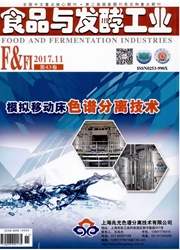

 中文摘要:
中文摘要:
采用邻二氮菲Fe^2+氧化法和DPPH法,研究5种壳聚糖及其衍生物——壳聚糖(chitosan)、壳寡糖(oligo—chitosan)、羧甲基壳聚糖(CM—chitosan)、N-乙酰氨基葡萄糖(GLcNAc)、氨基葡萄糖盐酸盐(GlcNH2·HCl)的体外清除羟自由基和DPPH·自由基的能力。结果表明:在实验设置的浓度范围内,对羟自由基的清除能力依次为oligo—chitosan〉chitosan〉GLcNAc〉GlcNH2·HCl〉CM-Chitosan,且其清除能力随着浓度的增加而增加。其中2mg/mL的Oligo—chitosan对羟自由基的清除率最大达到97.81%,相当于4mmol/L的Vc对羟自由基的清除能力。对DPPH·的清除能力大小依次为oligo—chitosan〉chitosan〉GlcNH2·HCl≥GLcNAc〉CM—chitosan,且其清除能力随着浓度的增加而增加。2mg/mL oligo-chitosan的清除率为97.34%,大于6mmol/L Vc的清除速率79.92%。2种方法测定的结果比较一致。
 英文摘要:
英文摘要:
The antioxidant activities in vitro of chitosan, caboxymethyl-chitosan (CM-Chitosan), oligo- chitosan, N-acetyl-glucosamine (GLcNAc) and GlcNH2· HCL were investigated by phenanthroline-Fe^2+ and DPPH methods. The results showed that in the setting concentration range, the antioxidant activities increased with the elevation of concentration. The activity of scavenging hydroxyl free radical of chitosan and its derivatives was that Oligo-chitosan 〉Chitosan〉GLcNAc 〉GlcNH2 · HCL〉CM-Chitosan. The highest scavenging rate of hydroxyl free radical using 2 mg/mL of Oligo-chitosan could be 97.81%, which was similar to the activity using 4 mmol/L of Vc. The activity of scavenging DPPH free radical was that Oligo-Chitosan〉Chitosan〉GlcNH2 · HCL≥GLcNAc〉CM-Chitosan. The highest scavenging rate of DPPH free radical using 2 mg/mL Oligo-chitosan could be 97. 34%, more than the rate 79.92% of 6mmol/L Vc. The results were consistent by two methods.
 同期刊论文项目
同期刊论文项目
 同项目期刊论文
同项目期刊论文
 期刊信息
期刊信息
